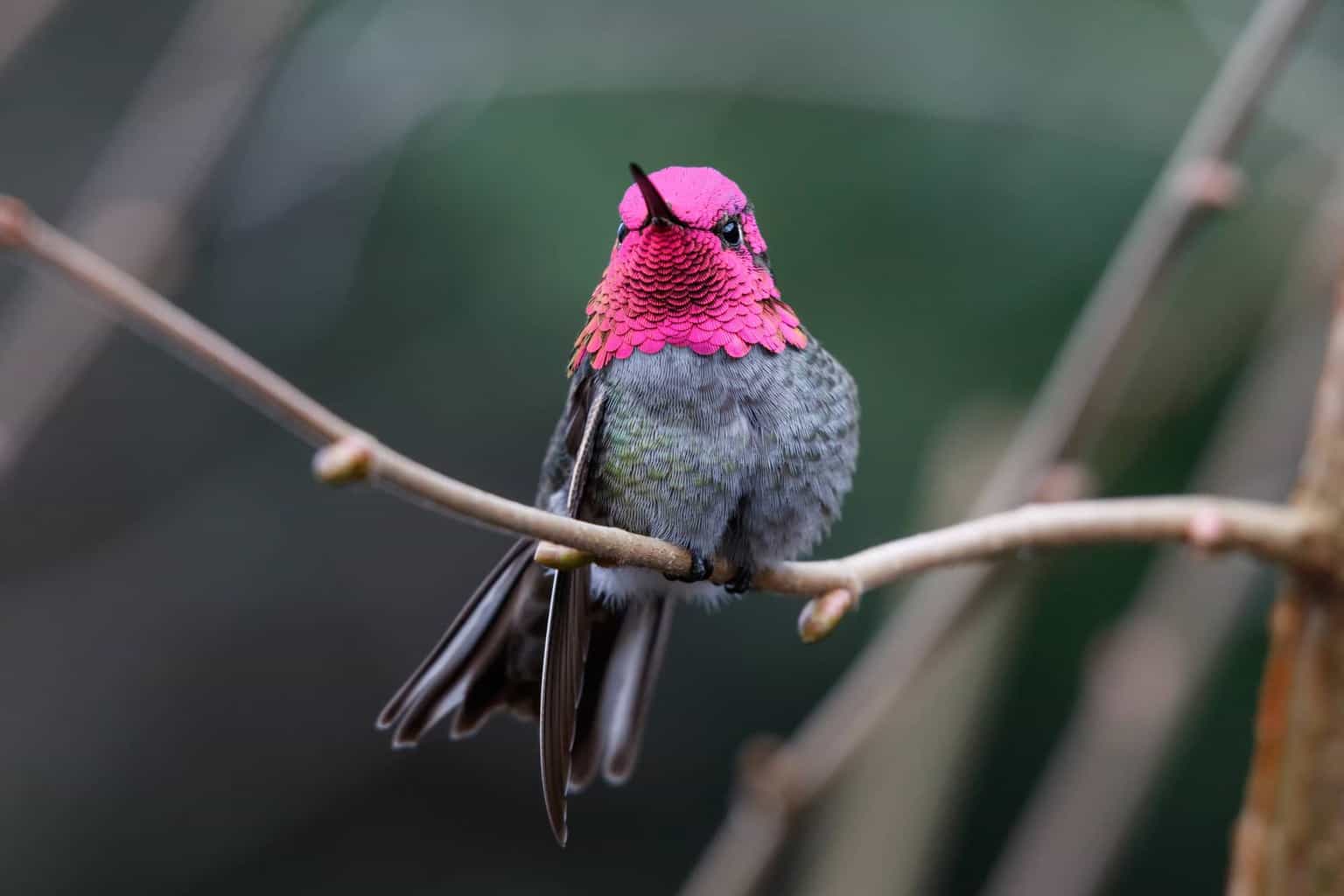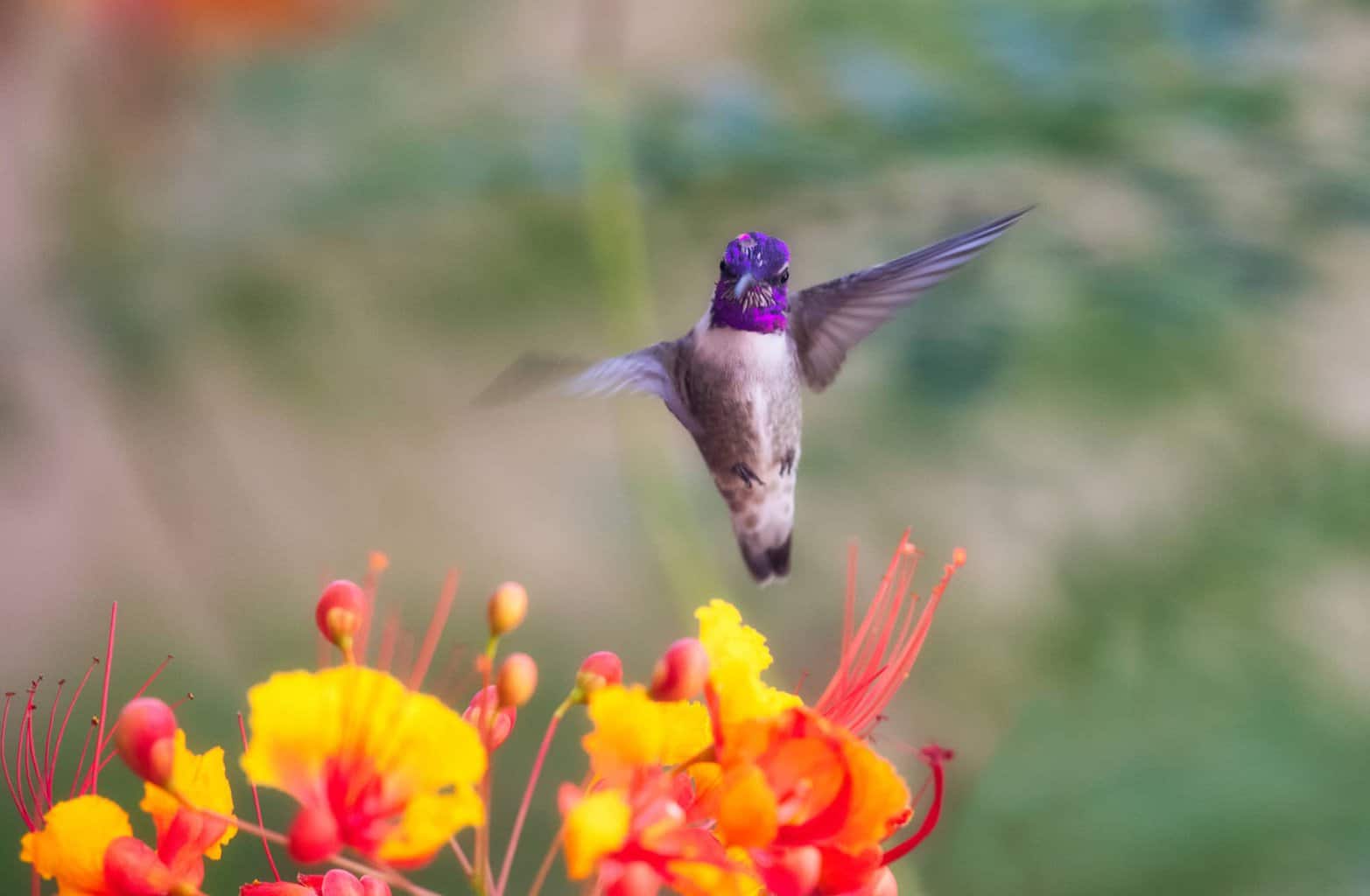The state of Oregon has varied climatic conditions. Along the coastline, average summer temperatures are around 57 degrees (70 degrees in the lowlands), while winter averages around 40 degrees.
There is a range of habitats within this state, including rainforests and other wooded areas (which cover approximately two-fifths of Oregon), mountains, coastlines, plateaus, rivers, deserts, and grasslands.
With all of this diversity in topography, climate, and vegetation, there are believed to be more than 500 bird species in Oregon.
Of these birds, nine species of hummingbirds occur in the state. These can be divided into two groups. Namely, those that appear frequently in preferred habitats (in one area at least) and those that are rare visitors.
Frequently Seen Hummingbird Species of Oregon
Most hummingbirds located in Oregon are “frequent flyers,” occurring in various localities around the state. These hummingbirds are either migratory hummingbirds or birds that nest.
Anna’s Hummingbird (Calypte anna)

- Length: 9 inches
- Weight: 1 – 0.2 ounces
- Wingspan: 7 inches
Description:
Male Anna’s hummingbirds have a bronze-green back, green sides, and a grey belly and chest. They also have red-pink feathers on their throats, all the way to their crowns.
Females are less striking than males, with greyer coloration. They may also have small amounts of red on their throats.
Additional Information:
Anna’s hummingbirds are distributed from California to Canada, along the west coast of the USA—and from the coastline to western Arizona.
The habitats Anna’s hummingbirds inhabit include city parks, gardens, coastal and other scrubs, open woods, and savannas.
Instead of migrating, they move on a migration route from lower elevations during the winter to higher elevations in the summer. These hummingbirds are the only species to be found year-round in Oregon.
Nectar from currant, gooseberry, and manzanita, along with insects (leafhoppers, midges, and whiteflies), constitute the bulk of Anna’s hummingbird diet.
Allen’s Hummingbird (Selasphorus sasin)

- Length: 5 inches
- Weight: 1 ounce
- Wingspan: 3 inches
Description:
Male Allen’s hummingbirds’ bellies, eye markings, and tails are copper, orange-red throats, and bronze-green backs. They also have white chests.
Females have lighter sides, bronze spots, and a small red-orange area on their throats. They have the same bronze-green and white color on their bodies.
Additional Information:
Allen’s hummingbirds are distributed from Oregon to California, mostly along the coastal plain during the summer breeding season.
The habitats they frequent include canyons, city parks, coastal forests, open oak woods, scrub, and suburbs with lots of trees.
These birds are commonly found up to Bandon. However, they are rare in other areas of Oregon. During migration, Allen’s hummingbirds move south to Mexico.
Allen’s hummingbirds’ diets consist primarily of nectar and insects, including ants, flies, and small beetles.
Black-chinned Hummingbird (Archilochus alexandri)

- Length: 5 inches
- Weight: 1 – 0.2 ounces
- Wingspan: 3 inches
Description:
Male Black-chinned hummingbirds have a diagnostic black throat, with a thin purple line underneath. They have a metallic green head, flanks, back, a grey-white underside, and a black bill.
Female Black-chinned hummingbirds lack the black throat and purple line. They have white tips on three of their dark tail feathers. Overall, they are less striking than the males.
Additional Information:
During the summer months, Black-chinned hummingbirds are distributed along the western coast of the USA from British Columbia south and eastwards to Texas. Including central Oregon.
Their preferred habitats include lowland deserts, mountainous forests, canyons, rivers, and built-up areas.
Black-chinned hummingbirds migrate to the Gulf of Mexico during the winter months, leaving in September and returning north in late February.
Nectar and insects form the bulk of their diets. Males are relatively aggressive, chasing away rival hummingbirds from food sources.
Broad-tailed Hummingbird (Selasphorus platycercus)

- Length: 1 – 3.5 inches
- Weight:1 – 0.2 ounces
- Wingspan: 25 inches
Description:
Male Broad-tailed hummingbirds have magenta throat feathers, white chests and bellies, green heads, backs, and flanks.
Female Broad-tailed hummingbirds are less striking than males, with green spots on their throats and white-tipped tail feathers.
Additional Information:
Broad-tailed hummingbirds’ distribution during the summer breeding season ranges from Western USA into Western Canada. They are found in the extreme east of Oregon.
These Broad-tailed hummingbirds frequent meadows and open woodlands, often between 5,000 and 10,500 feet, while during migrations, they make use of pine-oak forests, dry thorn forests, and tropical highlands in Mexico.
Their diet consists primarily of nectar from flowers and insects.
Calliope Hummingbird (Stellula calliope)

- Length: 1 – 3.5 inches
- Weight: 1 ounce
- Wingspan: 1 – 4.3 inches
Description:
Male Calliope hummingbirds have green backs, heads, wings, and tails. They also have characteristic magenta-colored throat feathers and white chests.
Females are less brightly colored than males, with green and white on their bodies as well. They also have a peach color on their underside.
Additional Information:
Calliope hummingbirds’ distribution ranges from southern Canada, through the western USA, to northern Mexico.
The habitats they frequent include aspen thickets, canyons, open forest glades, and mountain meadows, where their diet consists of nectar from flowers and insects.
Calliope hummingbirds move via the Pacific lowlands to the northwest in spring, and southeast via the Rocky Mountains during early fall, while they migrate.
Rufous Hummingbird (Selasphorus rufus)

- Length: 8 – 3.5 inches
- Weight: 1 – 0.2 ounces
- Wingspan: 3 inches
Description:
The male Rufous hummingbird has an orange head, back, and underside. They also have a striking red throat.
Female Rufous hummingbirds have green heads, backs, and dark tails, with rufous patches on their tails and rufous flanks. They occasionally have an orange throat spot.
Additional Information:
Rufous hummingbirds have a distribution that stretches from Alaska in the north, through the western USA to Mexico.
They are found in various habitats, including forest clearings, forests, and meadows, between sea level and 6,000 feet. Nectar and insects form their diets.
These Rufous hummingbirds are renowned for their aggressive behavior, often chasing larger hummingbird species away from feeders and flowers.
Rufous hummingbirds migrate south to Mexico and spend the winter in higher-elevation shrubby areas and oak/pine forests (7,500 to 10,000 feet).
Rarely Seen Visitor Hummingbirds of Oregon
Costa’s Hummingbird (Calypte costae)

- Length: 5 inches
- Weight: 1 ounce
- Wingspan: 3 inches
Description:
Male Costa’s hummingbirds have purple crowns and throat feathers. They also have a metallic green chest and back, with a white belly and flanks.
Females are less vivid, with faded metallic green backs and heads, white underparts, and a white eyebrow stripe.
Additional Information:
Costa’s hummingbirds are located in the southwestern USA, stretching northwards to British Columbia, Alaska, and Canada.
The habitats that this hummingbird species select range from desert scrub (including the Sonoran and Mojave Desert scrub and coastal California chaparral and sage scrub) to deciduous forests.
In Oregon, these exceedingly rare birds frequent the central and southwestern areas during the spring and summer seasons.
Costa’s hummingbirds’ diets consist of nectar and insects.
Broad-billed Hummingbird (Cynanthus latirostris)

- Length: 2 – 4 inches
- Weight: 1 ounce
- Wingspan: 5 inches
Description:
Male Broad-billed hummingbirds have metallic green bodies with blue throats, black tails, white underparts, and black-tipped red bills.
Female Broad-billed hummingbirds have a gold-green back and head, a white line from the eye moving backward, and grey undersides.
Additional Information:
Broad-billed hummingbirds are distributed from Mexico up into southwestern canyons of mountainous parts of the USA.
This hummingbird species is commonly found along streams in canyons and mountain meadows at altitudes of up to 9,800 feet.
During their migrations, these migratory hummingbirds go into Mexico for the winter period, Broad-billed hummingbirds occupy lowland thorn forests and tropical deciduous forests.
Their diet consists of nectar (from plants including Arizona sycamore, Fremont cottonwood, and desert willow) and insects.
Xantus’s Hummingbird (Basilinna xantusii)
- Length: 3 – 3.5 inches
- Weight: 11 – 0.14 ounces
- Wingspan: 5 inches
Description:
Male Xantus’s hummingbirds have a green back with a red-brown tail. They are cinnamon-brown underneath. Males have a green throat and crown with a red bill.
The cinnamon color extends to females to cover their throats as well. Both males and females have a white eye stripe and a black mask.
Additional Information:
Xantus’s hummingbirds mostly occur around Mexico and Central America. However, one female attempted to nest in California, while another flew to British Columbia.
These birds are found in desert scrub, gardens, montane pine-oak woods, and scrubby woodland.
This hummingbird species is not seen in Oregon often, aside from the one or two migratory hummingbird outliers who strayed far from their normal distribution.
Conclusion
Hummingbirds found in Oregon include those that are frequently found and those that are only rarely found.
Of the nine or so Oregon species, Anna’s hummingbirds are year-round residents. The rest are migratory hummingbirds for a season. Many breed in Oregon during the summer and migrate to Mexico.
Certain species, such as Costa’s hummingbird, appear more frequently in Oregon, which could be linked to climate change.

